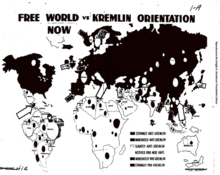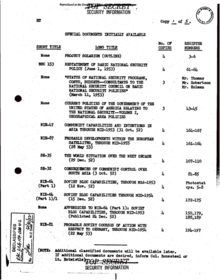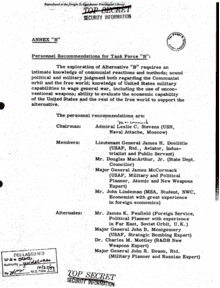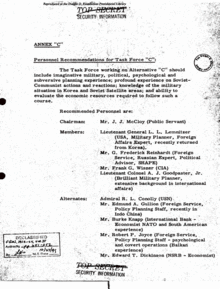Project Solarium
Project Solarium was an American national-level exercise in strategy and foreign policy design convened by President Dwight D. Eisenhower in the summer of 1953. It was intended to produce consensus among senior officials in the national security community on the most effective strategy for responding to Soviet expansionism in the wake of World War II. The exercise was the product of a series of conversations between President Eisenhower and senior cabinet-level officials, Secretary of State John Foster Dulles and George F. Kennan among them,[1] in the Solarium room on the top floor of the White House. Through these conversations, Eisenhower not only realized that strategic guidance set forth in NSC 68 under the Truman administration was not sufficient to address the breadth of issues with which his administration was presented, but also that his own cabinet was divided enough on the correct course of action vis-a-vis the Soviet Union that United States' policy on dealing with the Soviet Union was at risk of becoming subject to internal political posturing to the detriment of US national security.
Project Solarium is significant in that its findings produced NSC 162/2, a national strategy directive commonly assessed to have guided US strategy from its publication to the end of the Cold War.

History
On the heels of his 'Cross of Iron' speech in April 1953, President Eisenhower was increasingly concerned about the trajectory of US foreign policy, in as much as it leaned heavily toward militancy vis-a-vis the Soviet Union. One component of Eisenhower's campaign platform was harsh criticism of unsustainable military expenditures, given the risk such expenditures posed to the stability and long term growth potential of the US economy.[2] Senior figures in his administration were at odds over the nature of the United States' policy of engagement towards the Soviet Union, with much of the disagreement drawn between two camps in his administration: a group of senior officials who asserted that the only viable means of defending the United States against Soviet expansionism was to actively combat and 'roll back' the sphere of Soviet influence lest it be allowed to threaten United States' sovereignty, and those who supported the 'strategy of containment' as espoused by George F. Kennan, the author of the Long Telegram and director of the Policy Planning staff at the US Department of State.
Eisenhower realized that unless a single narrative for Soviet engagement could be agreed upon within his own administration, efforts to further competing agendas within the administration would lead to incoherence in the US approach to combating the rise of Soviet communism. In order to unify his senior staff, Eisenhower ordered that a strategy design exercise be convened in order to allow for his staff to come together and agree upon a central theme for Soviet engagement that would guide his administration's actions going forward.
Process structure
The exercise involved the use of three teams of experts, each team having an assigned mission to analyze and present a supporting case for one of three overarching themes as the basis for US policy on the Soviet Union.[3] These teams were all provided with a series of common reference documents and intelligence assessments to aid each team's analysis.[4]

The three teams were referred to as 'Task Forces,' and were composed of leading experts from the federal government and academia known for their particular knowledge of Soviet strategy, politics, economics, military capability, intelligence activities, diplomatic posture and history.
Each Task Force was initially set the task of analyzing its given position and providing critical assessment of that position's efficacy, to include its strengths and weaknesses. Though President Eisenhower realized that the three courses of action to be analyzed could be combined or modified in any number of varying interpretations, he thought it most effective to set down three specific lines of thought for comparison to ensure that all three positions could be evaluated on their own merit.
Each task force met individually or in plenary format between June 10 and July 15, 1953, and submitted independent reports to the National Security Council and President Eisenhower summarizing each team's findings.

Team A

Team A – headed by George Kennan – was bound to a mainly political strategy toward the Soviet Union, focused primarily on Europe, and eschewing significant military commitments elsewhere. It also relied heavily on US allies and placed a priority on alliance cohesion.[5] Team A would make the best possible argument for the existing policy of containment, seeking to prevent Soviet expansion in Europe while minimizing the risk of general war.[1]
Team A participants:
George Kennan, Chairman; C. Tyler Wood, RADM H. P. Smith, COL G. A. Lincoln USA, COL C. H. Bonesteel III USA, CAPT H. E. Sears USN, John M. Maury, CIA
Team B

Eisenhower gave Team B a similar mandate but allowed it to take a harder line towards the Soviet Union, and instructed it to contemplate policies that relied less on allies per se and more on the US nuclear arsenal. It was given, therefore, a more unilateral mission but one that nevertheless held to a clear line against taking direct military action within the Soviet sphere of influence.[5] Team B would accept containment as a viable policy, but be less tentative about its implementation. It would assert that any Soviet or Soviet-sponsored aggression would lead to general war and threaten massive US and allied retaliation using any means necessary.[1]
Team B participants:
MGEN James McCormack USA, John C. Campbell, MGEN John R. Deane USA (Ret.), Calvin B. Hoover, Col. Elvin S. Ligon USAF, Philip E. Mosely, James K. Penfield
Team C

Team C was the "roll-back" team. Nitze was excluded from the project but Team C's mandate was taken almost verbatim from the prescriptive passages of NSC-68: diminish Soviet power – and Soviet-controlled territory – everywhere and by any means available.[5]
Team C participants:
VADM R. L. Connolly, LTG L. L. Lemnitzer USA, G. F. Reinhardt, Kilbourne Johnston, COL Andrew J. Goodpaster USA, Leslie S. Brady, COL Harold K. Johnson USA
Operational security measures associated with Solarium

Given the sensitive nature of the exercise, significant measures were taken to obfuscate its true purpose. Though the exercise itself was conceived by Eisenhower at the White House, he chose to hold the exercise at the National War College under the rubric of the 'First National War College Round Table Seminar,' the subject of the seminar being 'American Foreign Policy, 1953 - 1961.' To add layers of backstopping to this cover story, the National War College produced conference agendas, booklets and pamphlets about the seminar to hand out to Solarium participants and National War College staff.

Participants were held to strict standards of non-disclosure regarding their participation in Solarium leading up to its execution and following the presentation of the exercise findings to the National Security Council in June 1953.[6] Even the existence of Solarium itself, the participants and the outcomes, were not declassified or officially acknowledged until 1985.[2]
Findings
The three panels submitted reports to the National Security Council after approximately 45 days of analysis and an additional 30 days of deliberation. Though each team presented a different case as was prescribed, President Eisenhower summarized the findings of the exercise in these general terms,[2] which aligned generally with the findings of Team A:
1. The Soviet Union was a long term, rather than an imminent, threat, and one that would diminish if the United States acted prudently.
2. The threat was from Soviet troop strength, conventional weaponry, and a tendency to use intimidation and alliances to further its goals of creating a security zone in Eastern Europe and Asia, and of overthrowing independent governments. None of these were as important, however, as the increasing number of nuclear weapons in the possession of the Soviets and concomitantly their capacity to deliver them.
3. The United States needed to avoid both public alarm – which could bring excessive military preparations - and complacency – which might encourage the Soviet Union and its allies to take risks, as in Korea. The United States thus should maintain a system of alliances circumscribing the Soviet Bloc and military readiness, both conventional and nuclear.
4. The United States would pursue its national security in conjunction with its allies, and this pursuit would involve, not rollback of Soviet power, but a continuation of containment.
5. The most useful strategy for the United States, once it had established its deterrent capacity and resolve, would be political and educational – conveying the truth about capitalism, democracy and human rights by various means to the populations of Eastern Europe and the Soviet Union.
Impact on US national strategy during the Cold War
NSC 162/2
The summary report resulting from the Solarium exercise formed the basis for NSC 162/2, which in many ways solidified the existing policy of containment toward the Soviet Union. The text of NSC 162/2 can be seen to incorporate lines of thought from Kennan's camp, Paul Nitze and President Eisenhower's own beliefs in the prudent limitation of military spending in the interest of maintaining the long term growth potential of the US economy. The blending of these three lines of thought led to a document that prescribed a strategy that played to the United States' strengths, placed a premium on the importance of alliances with developed and developing nations, and supported constant partial military mobilization with a buildup of the United States' nuclear arsenal to unprecedented levels, while continuing to place an overall priority on "Measures Short of War" as the primary means of containing Soviet aggressive behavior. NSC 162/2 served as the basis for what was dubbed the "New Look" of US foreign policy under the Eisenhower administration, and ultimately guided US policy toward the Soviet Union for the bulk of the Cold War.
Impact as an exercise in strategy design
As an exercise in national strategy design, Solarium is unique and has yet to be repeated in any comprehensive fashion. Though various presidential administrations have sought to emulate Solarium, none have since reproduced it successfully.[7]
See also
- The Hawk and the Dove (book)
- Present at the Creation: My Years in the State Department
- The Wise Men (book)
References
- 1 2 3 http://www.eisenhowerinstitute.org/about/living_history/solarium_for_today.dot
- 1 2 3 http://www.rose-hulman.edu/~pickett/Solarium.pdf
- ↑ Grundman, Steven (August 3, 2017). "Opinion: Lessons From A Korean War-Era National Security Exercise". Aviation Week. Retrieved August 4, 2017.
- ↑ http://commons.wikimedia.org/wiki/File:AvailableDocuments_Solarium_TOC.jpg
- 1 2 3 http://www.nato.int/docu/review/2006/issue1/english/special.html
- ↑ http://commons.wikimedia.org/wiki/File:SolariumOPSEC.jpg
- ↑ http://www.ndu.edu/ITEA/storage/796/Strategic%20Planning%20for%20NatSec.pdf
External links
- 'Cross of Iron' speech excerpt
- https://www.cia.gov/library/center-for-the-study-of-intelligence/kent-csi/vol18no2/pdf/v18i2a01p.pdf